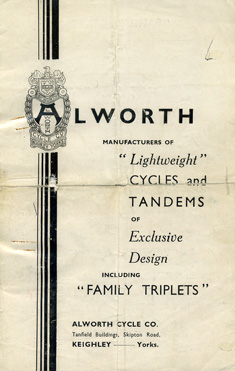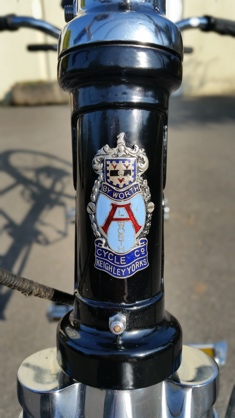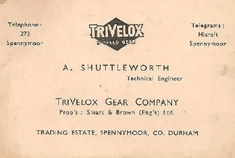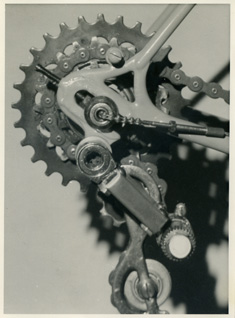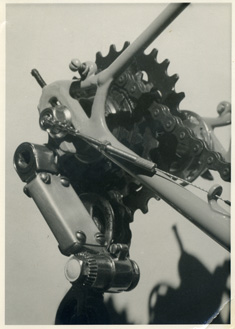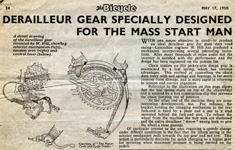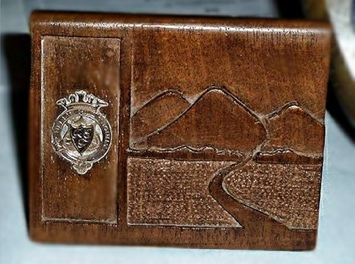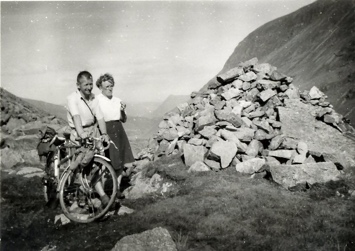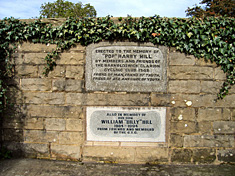Postscript
In the early-to-mid 1930s, Alec Shuttleworth and William Hill of Keighley, the patentees of the original, in-line TriVelox gear, went their separate ways. Alec Shuttleworth remained in Keighley. William Hill decided to move to Coventry, working first for Triumph Company Limited, and then Coventry Bicycles Limited and its subsidiary, TriVelox Gears Limited.
What happened to the two men in later life and to their respective interests in the TriVelox gear? In the early 1930s Alec Shuttleworth decided to stop dealing in motor cars and motorcycles and sell off the front part of Tanfield Garage. He then opened a shop on the remaining part of the site, facing Campbell Street, and concentrated entirely on selling bicycles. A late 1930s photograph of the shop shows Alec standing outside the doorway. He was at the time a vice-president of two local cycling clubs: the Bronte Wheelers and the Keighley Road Club.
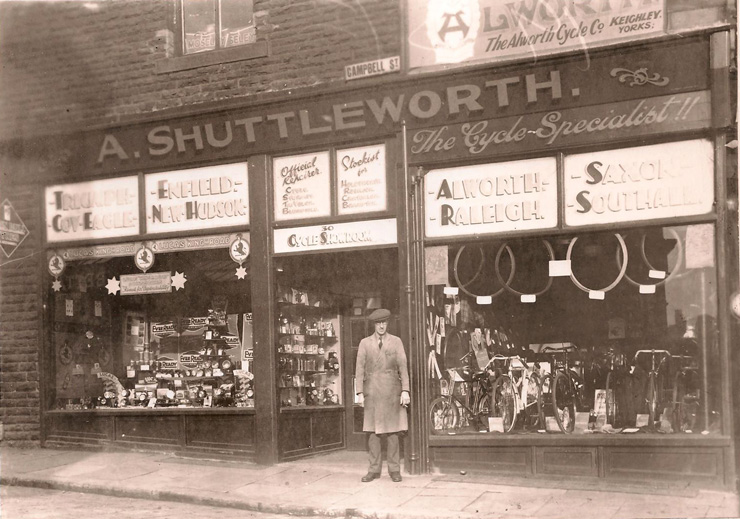
Photograph of Alec Shuttleworth standing outside his shop, courtesy of Tim Clapham
The names of his suppliers, given above the windows of the shop, make for interesting reading. For example, he had clearly established a link with Coventry companies in that Triumph and Cov[entry]-Eagle were both represented: and the name [Frank] Southall would be familiar to all cycling enthusiasts of the 1930s. Not to be outdone, he had bracketed his own brand of bicycle, the Alworth, with the world-famous Raleigh!
The Alworth Cycle Company produced a rather unusual brochure. Many of the "Lightweight" cycles were single-speed, fixed-wheel models. In contrast, "Family Triplets", as one would expect, were shown with three-speed, TriVelox gears. Rather surprisingly, Sturmey Archer or Cyclo three-speed gears could be fitted to order!
Michael Palmer of Wells in Somerset has restored an Alworth Family Triplet that is fitted with an A-4 TriVelox gear from Smart & Brown:
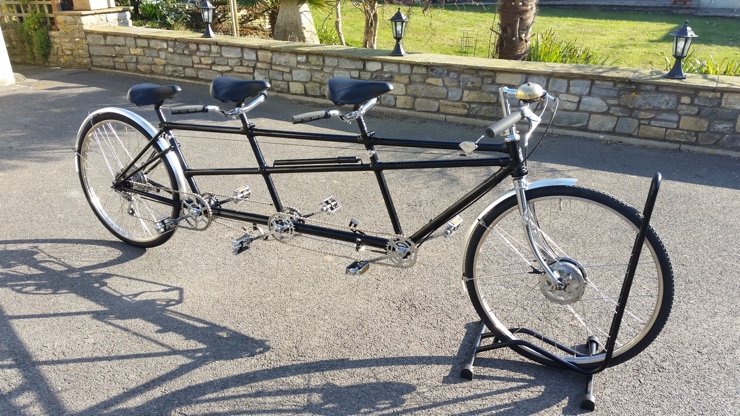
A close-up photograph of the TriVelox gear on this tandem, together with the Family Triplet page from an Alworth catalogue, may be seen here. The photographs of the tandem, its gear, and its head tube (shown above) are all courtesy of Michael Palmer.
In about 1944, following a job offer from Smart & Brown, an offer probably linked to the arrangement he had come to with the company over the TriVelox gear, Alec sold Alworth Cycles to the same people who had earlier purchased the major part of the Tanfield Garage premises, and accepted the job. Until the end of the war he worked for Smart & Brown at its site in Cottingley. Later he moved to the company's Spennymoor factory to work as a technical engineer, as his business card shows. But not long after arriving in Spennymoor a heart attack caused him to retire early and he returned to Yorkshire. Despite this setback to his health he went on to live for a further twenty years and more.
What about William Hill? Following the demise of TriVelox gear production in Coventry in 1940 he returned to Yorkshire and worked for the remainder of the war at Jowett Cars Limited in Idle, near Bradford. After the war he worked, successively, as a frame builder at Hill Brothers in Padiham, manufacturers of Hill Special bicycles (Adam and Tom Hill, the proprietors, were no relation); as a bicycle mechanic at Tom Hargreaves's bicycle shop in Colne; and finally at Crompton & Knowles Limited, a packaging machinery company in Nelson. A former colleague at Crompton & Knowles has described Bill thus [1]:
'The man who was in charge of the research and development team [at Crompton & Knowles] was a wonderful engineer with an equally wonderful character, his name was Bill Hill. I was later to discover that this man, who was small in stature, once cycled for England in the 1928 Olympics. He told me he had designed and patented a multi-change gear unit for bicycles later marketed by a foreign company and invented a special light weight cycle frame tube. I was a bit sceptical until he assured me samples were in the National Science Museum in London.'
There are two slightly misleading assertions here. Bill competed for England in the 1928 Workers' Olympiad in Moscow - much to the irritation of Alec Shuttleworth - and not the Olympic Games. (A photograph of Bill in Moscow and a recording of him talking about his experiences there can be seen and heard here.) One can only assume that by 'foreign company' Bill was referring to the Triumph Company and Siegfried Bettmann. There is, however, an example of the TriVelox gear in the Science Museum in Kensington! [2]
During his post-war career Bill continued to experiment with a number of gears. These included a four-speed TriVelox which incorporated 'modifications to the last model T.V.' as he put it. Included among his papers are two photographs of this gear: each has some pencilled comments by Bill on its reverse side.
The comments on the reverse of the first photograph include 'control on gear side (pull into low gear, spring return into top gear)' and 'I prefer track ends as wheel can be removed away from jockey system'. His final comment on the back of the second photograph is succinct and to the point:
The factory [Priory Street in Coventry] was destroyed during the "Coventry Blitz". Remaining stocks sold to Smart & Brown at Spennymoor, County Durham. "They hadn't a clue". Result disaster.
Bill also left evidence of his interest in the modern free-hub, such as the one manufactured by Shimano, by making a rough sketch of how the design of the latter compared to the TriVelox design. This sketch, together with the reverse sides of the two photographs [of the 4-speed gear], can be viewed here.
In addition to experimenting with a four-speed variant of the TriVelox gear, Bill patented in 1949 a derailleur gear that was described in a review in a 1950 issue of The Bicycle, as being specially designed for the 'Mass Start Man'. An earlier review in The Motor Cycle and Cycle Trader, dated 13 January 1950, stated that 'the gear in its present form will work either as a three- or four-speed model with 1/8 in chain, and could be used as a five-speed with a 3/32 in'. William Hill was moving into the modern era! However, the gear is not mentioned in Berto, The Dancing Chain, and so it is unlikely it ever went into production.
Bill and his wife Nellie continued cycling on their tandem into old age. For many years they were active members of The Rough Stuff Fellowship, 'The original off-road cycle touring and mountain biking club.' Following Nellie's death in 1978 the Fellowship introduced the Nellie Hill Trophy, awarded each year for the best rough-stuff slide or digital photograph.
From 1978 onwards, Bill rode solo on a classic, Hill Special-framed bicycle. He finally gave up cycling in 1990 and died in Colne four years later, the day after his ninetieth birthday. He is commemorated, along with his father, on a memorial seat at Bracewell near Barnoldswick.
The couplet on the Harry Hill memorial tablet reads as follows:
Friend of man, friend of truth,
Friend of age and guide of youth.
It is adapted from a poem by Robert Burns,
Epitaph On My Own Friend [William Muir], 1784.
Notes
1. Alan Duffy. My Ladder of Life. Leicester: Matador, an imprint of Troubadour Publishing Limited, 2011, page 56.
2. C.F. Caunter. The History and Development of Cycles: As Illustrated by the Collection of Cycles in the Science Museum. London: Science Museum, 1972, page 57. The book gives the reference (Inv. 1932-617) for the Museum's TriVelox gear. This is an excellent book on the history of bicycle design. However it is now very dated and includes a number of myths, such as the one which credits the Scotsman, Kirkpatrick Macmillan, with the invention in the late 1830s of a precursor to the Velocipede or Boneshaker; and that H.J. Lawson built a chain-driven, rear-driving safety bicycle in 1873-74. For more up-to-date histories on the development of the bicycle see the following books, which are listed in chronological order: Andrew Ritchie. King of the Road: An Illustrated History of Cycling. London: Wildwood House, 1975; David Gordon Wilson. Bicycling Science. 3rd edition. Cambridge, MA: The MIT Press, 2004; Tony Hadland and Hans-Erhard Lessing. Bicycle Design: An Illustrated History. Cambridge, MA: The MIT Press, 2014; Chris Boardman with Chris Sidwells. The Biography of the Modern Bike. London: Cassell, 2015; Carlton Reid. Roads Were Not Built For Cars: How Cyclists Were the First to Push For Good Roads & Became the Pioneers of Motoring. Washington: Island Press, 2015; Nick Clayton. The Birth of the Bicycle. Stroud: Amberley, 2016; Dorling Kindersley. Bicycle: The Definitive Visual History. London: Dorling Kindersley, 2016; and Andrew Ritchie. Early Bicycles and the Quest for Speed: A History, 1868-1903. 2nd edition. Jefferson, North Carolina: McFarland & Company, 2018 For the H.J. Lawson myth in particular, and the development of the safety bicycle in general, see: Derek Roberts, editor. The Invention of the Safety Bicycle. 3rd edition. Mitcham: By the Author, 1993. This booklet is available from the Veteran-Cycle Club Sales Officer at this address clubsales@v-cc.org.uk.
